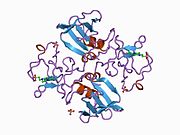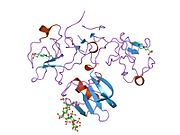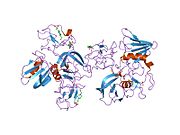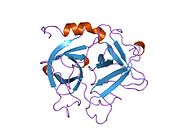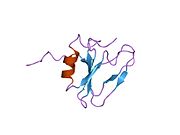Faktor rasta hepatocita
| edit |
| Faktor rasta hepatocita (hepapoietin A) | |||||||||||
|---|---|---|---|---|---|---|---|---|---|---|---|
 PDB prikaz baziran na 1bht. | |||||||||||
| Dostupne strukture | |||||||||||
| 1bht, 1gmn, 1gmo, 1gp9, 1nk1, 1shy, 1si5, 2hgf | |||||||||||
| Identifikatori | |||||||||||
| Simboli | HGF; F-TCF; HGFB; HPTA; SF | ||||||||||
| Vanjski ID | OMIM: 142409 MGI: 96079 HomoloGene: 503 GeneCards: HGF Gene | ||||||||||
| |||||||||||
| Pregled RNK izražavanja | |||||||||||
 | |||||||||||
 | |||||||||||
 | |||||||||||
| podaci | |||||||||||
| Ortolozi | |||||||||||
| Vrsta | Čovek | Miš | |||||||||
| Entrez | 3082 | 15234 | |||||||||
| Ensembl | ENSG00000019991 | ENSMUSG00000028864 | |||||||||
| UniProt | P14210 | O55027 | |||||||||
| RefSeq (mRNA) | NM_000601 | NM_010427 | |||||||||
| RefSeq (protein) | NP_000592 | NP_034557 | |||||||||
| Lokacija (UCSC) | Chr 7: 81.17 - 81.24 Mb | Chr 5: 16.07 - 16.13 Mb | |||||||||
| PubMed pretraga | [1] | [2] | |||||||||
Faktor rasta hepatocita (HGF/SF) je morfogeni faktor koji utiče na parakrini ćelijski rast i motilitet. Njega izlučuju mezenhimalne ćelije. On prvenstveno deluje na epitelne i endotelne ćelije, ali i na hematopoietske progenitorne ćelije. Pokazano je da ima značajnu ulogu u embrionskom razvoju organa, u regeneraciji organa kod odraslih osoba i zarastanju rana.[1]
Faktor rasta hepatocita reguliše ćelijski rast, ćelijsku mobilnost i morfogenezu putem aktiviranja signalne kaskade tirozinskih kinaza nakon vezivanja za proto-onkogeni c-Met receptor. Faktor rasta hepatocita izlučen iz mezenhimalnih stem ćelija dejstvuje kao multi-funkcionalni citokin. Njegova sposobnost da stimuliše mitogenezu i ćelijsku motilnost daje mu centralnu ulogu u angiogenezi, tumorogenezi, i regeneraciji tkiva. On se izlučuje kao neaktivni polipeptid, koga presecaju serinske proteaze u 69-kDa alfa-lanac i 34-kDa beta-lanac. Disulfidna veza između alfa i beta lanaca proizvodi aktivni, heterodimerni molekul. Ovaj protein pripada plazminogen potfamiliji S1 peptidaza, ali nema primetnu proteaznu aktivnost. Alternativno splajsovanje ovog gene proizvodi višestruke transkriptne varijante koje kodiraju razne izoforme.[2]
Interakcije[uredi | uredi kod]
Za faktor rasta hepatocita je pokazano da interaguje sa C-Met.[3][4]
Vidi još[uredi | uredi kod]
- Faktor rasta
- Receptor faktora rasta hepatocita (HGFR)
Reference[uredi | uredi kod]
- ↑ Gallagher, J.T., Lyon, M. (2000). „Molecular structure of Heparan Sulfate and interactions with growth factors and morphogens”. u: Iozzo, M, V.. Proteoglycans: structure, biology and molecular interactions. Marcel Dekker Inc. New York, New York. str. 27–59.
- ↑ „Entrez Gene: HGF hepatocyte growth factor (hepapoietin A; scatter factor)”.
- ↑ Comoglio, P M (1993). „Structure, biosynthesis and biochemical properties of the HGF receptor in normal and malignant cells”. EXS (SWITZERLAND) 65: 131–65. ISSN 1023-294X. PMID 8380735.
- ↑ Naldini, L; Weidner K M, Vigna E, Gaudino G, Bardelli A, Ponzetto C, Narsimhan R P, Hartmann G, Zarnegar R, Michalopoulos G K (October 1991). „Scatter factor and hepatocyte growth factor are indistinguishable ligands for the MET receptor”. EMBO J. (ENGLAND) 10 (10): 2867–78. ISSN 0261-4189. PMC 452997. PMID 1655405.
Literatura[uredi | uredi kod]
- Nakamura T (1992). „Structure and function of hepatocyte growth factor.”. Prog. Growth Factor Res. 3 (1): 67–85. DOI:10.1016/0955-2235(91)90014-U. PMID 1838014.
- Ware LB, Matthay MA (2002). „Keratinocyte and hepatocyte growth factors in the lung: roles in lung development, inflammation, and repair.”. Am. J. Physiol. Lung Cell Mol. Physiol. 282 (5): L924–40. DOI:10.1152/ajplung.00439.2001. PMID 11943656.
- Funakoshi H, Nakamura T (2003). „Hepatocyte growth factor: from diagnosis to clinical applications.”. Clin. Chim. Acta 327 (1-2): 1–23. DOI:10.1016/S0009-8981(02)00302-9. PMID 12482615.
- Skibinski G (2004). „The role of hepatocyte growth factor/c-met interactions in the immune system.”. Arch. Immunol. Ther. Exp. (Warsz.) 51 (5): 277–82. PMID 14626426.
- Kalluri R, Neilson EG (2004). „Epithelial-mesenchymal transition and its implications for fibrosis.”. J. Clin. Invest. 112 (12): 1776–84. DOI:10.1172/JCI200320530. PMC 297008. PMID 14679171.
- Hurle RA, Davies G, Parr C, et al. (2006). „Hepatocyte growth factor/scatter factor and prostate cancer: a review.”. Histol. Histopathol. 20 (4): 1339–49. PMID 16136515.
- Kemp LE, Mulloy B, Gherardi E (2006). „Signalling by HGF/SF and Met: the role of heparan sulphate co-receptors.”. Biochem. Soc. Trans. 34 (Pt 3): 414–7. DOI:10.1042/BST0340414. PMID 16709175.
- Gallagher, J.T., Lyon, M. (2000). „Molecular structure of Heparan Sulfate and interactions with growth factors and morphogens”. u: Iozzo, M, V.. Proteoglycans: structure, biology and molecular interactions. Marcel Dekker Inc. New York, New York. str. 27–59.
